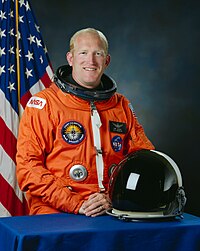Charles D. Gemar
| Charles D. Gemar | |
|---|---|
 | |
| Land | USA |
| Organisation | NASA |
| ausgewählt | 4. Juni 1985 (11. NASA-Gruppe) |
| Einsätze | 3 Raumflüge |
| Start des ersten Raumflugs | 16. November 1990 |
| Landung des letzten Raumflugs | 18. März 1994 |
| Zeit im Weltraum | 24d 5h 38min |
| ausgeschieden | 1996 |
| Raumflüge | |
Charles Donald „Sam“ Gemar (* 4. August 1955 in Yankton, South Dakota) ist ein ehemaliger US-amerikanischer Astronaut.
Ausbildung
Gemar erhielt 1979 einen Bachelor in Maschinenbau von der United States Military Academy. 1973 trat Gemar in die U.S. Army ein und erhielt dort 1980 den Pilotenschein.
Astronautentätigkeit
Im Juni 1985 wurde Gemar von der NASA als Astronautenanwärter ausgewählt.
STS-38
Gemar startete am 15. November 1990 als Missionsspezialist mit der Raumfähre Atlantis zu seinem ersten Flug ins All. Im Auftrag des US-Verteidigungsministeriums wurde als Nutzlast ein militärischer Spionagesatellit ausgesetzt.
STS-48
Am 12. September 1991 startete Gemar als Missionsspezialist mit der Raumfähre Discovery in den Weltraum. Bei dieser fünftägigen Mission wurde der UARS-Satellit zur Erforschung der oberen Erdatmosphäre ausgesetzt. Der 6,5-Tonnen-Satellit führte eine der detailliertesten Studien der Erdatmosphäre durch, inklusive der Ozonschicht.
STS-62
Am 4. März 1994 startete Gemar als Missionsspezialist mit der Raumfähre Columbia zu seinem dritten Weltraumflug. Nutzlast waren die United States Microgravity Payload 2 (USMP) und Office of Aeronautics and Space Technology 2 (OAST). Mit diesen Nutzlasten konnten die Auswirkungen der Schwerelosigkeit erforscht werden.
Nach der NASA
Seit Juli 1998 ist Gemar Leiter der Abteilung Flight Test Operations & Safety am Bombardier Flight Test Center in Wichita, Kansas.
Privates
Charles Gemar ist verheiratet und hat zwei Kinder.
Siehe auch
Weblinks
- Kurzbiografie von Charles D. Gemar bei spacefacts.de
- NASA-Biografie von Charles D. Gemar (englisch; PDF)
- Biografie von Charles D. Gemar in der Encyclopedia Astronautica (englisch)
| Personendaten | |
|---|---|
| NAME | Gemar, Charles D. |
| ALTERNATIVNAMEN | Gemar, Charles Donald (vollständiger Name); Gemar, Sam (Spitzname) |
| KURZBESCHREIBUNG | US-amerikanischer Astronaut |
| GEBURTSDATUM | 4. August 1955 |
| GEBURTSORT | Yankton, South Dakota |
Auf dieser Seite verwendete Medien
STS-62 Mission Insignia
Emblem of Nasa's STS-38 mission.
NASA Astronaut Charles D. (nickname Sam) Gemar
STS-48 Mission Insignia
- Designed by the astronaut crewmembers, the STS 48 patch represents the Space Shuttle Orbiter Discovery in orbit about the Earth after deploying the Upper Atmospheric Research Satellite (UARS) depicted in block letter style. The stars are those in the Northern Hemisphere as seen in the fall and winter when UARS will begin its study of Earth's atmosphere. The color bands on Earth's horizon, extending up to the UARS spacecraft, depict the study of Earth's atmosphere. The triangular shape represents the relationship among the three atmospheric processes that determine upper atmospheric structure and behavior: chemistry, dynamics and energy. In the words of the crewmembers, This continuous process brings life to our planet and makes our planet unique in the solar system."



